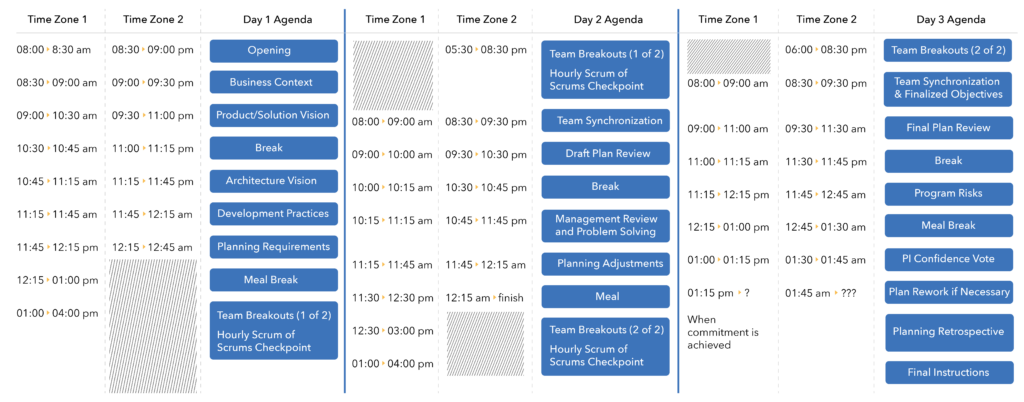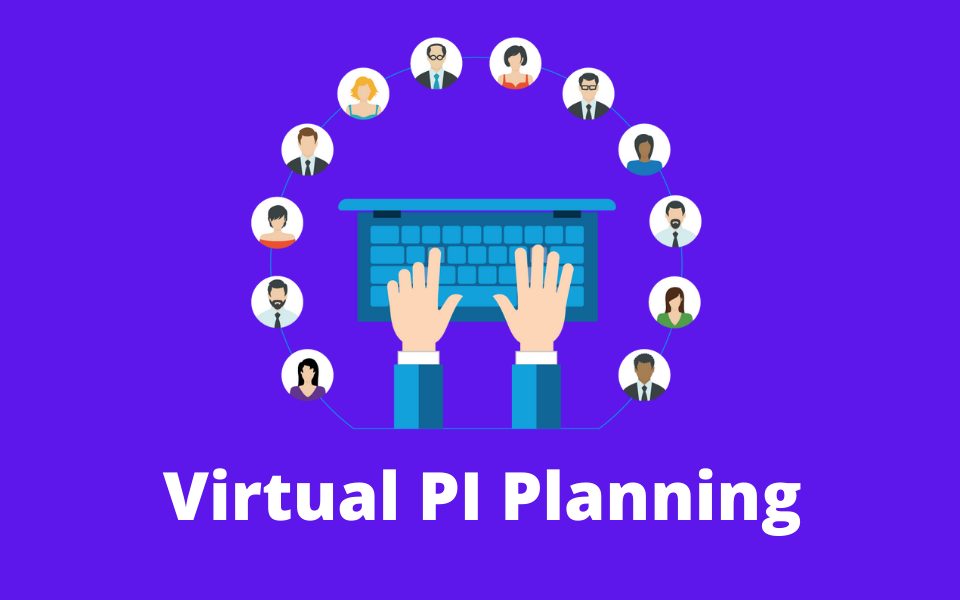5 Pitfalls You Should Avoid When Conducting Virtual PI Planning
If there’s an event that acts as a pillar to the success of every process implemented in the Scaled Agile Framework, it is PI Planning. It brings all ART stakeholders together before every Program Increment to ensure all the teams align under a shared vision and mission.
Even though traditional SAFe standards describe PI Planning as an event that requires physical collocation and face-to-face communication, committing to this practice has become difficult in today’s business climate with the abundance of geographically distributed teams and the ongoing Covid-19 crisis. Therefore, virtual or hybrid PI Planning events, conducted with the help of video conferencing and collaborative tools, have become widespread as a solution to these difficulties.
Inevitably, taking PI Planning to a virtual world brings many new challenges, particularly with the limitations it adds to the biggest contributors to the event’s success, face-to-face communication. They have pushed organizations to develop strategies to create an environment ideal for collaboration and communication during virtual PI Planning to preserve its expected effectiveness.
If you, too, are devising a plan for conducting virtual PI Planning events as effective as physical sessions, this post talks about five pitfalls you must avoid during the process to receive the intended outcome.
Lack of prior planning before the event
Prior planning is vital for the success of any PI Planning session, but it becomes even more indispensable when the event goes virtual. Planning allows you to control the variables that can negatively affect the session, leaving little room for time wastes, technical and logistical confusions, and unexpected disturbances.
Refining the Program Backlog is the most crucial part of this planning phase. During this process, you should reorganize the Backlog based on priorities and pick the top 10 features to be implemented in the next PI. You can use a prioritization model like Weighted Shortest Job First (WSJF) to make this task less subjective to individual opinions.
In virtual PI Planning, the sooner everyone comes to a shared understanding of the key points and how they are addressed in the event, the easier it would be to retain everyone’s attention despite the physical distance. Sharing the event agenda and the resources used during PI Planning—such as presentations, videos, and additional notes—ahead of time allows everyone to build at least a partial understanding of these details by the time they attend the event.
Usually, a virtual PI Planning event relies on a number of technologies that many participants wouldn’t be familiar with, especially at the early stages. Therefore, introducing all these new tools would also be a task to be conducted during the planning process. Confirming the availability of stakeholders crucial to PI Planning, like product managers and product owners, ahead of time should also be a part of the planner’s responsibility.
Not co-locating even when it’s possible
As the Agile Manifesto states, face-to-face communication is “The most efficient and effective method of conveying information to and within a development team.” Even though virtual PI Planning is conducted with the help of online and video-conferencing tools by principle, you shouldn’t hesitate to take advantage of co-locating and physical communication whenever possible.
With teams distributed across multiple locations, co-locating the entire ART in one place may be too costly and difficult to achieve. However, it doesn’t prevent teams located in the same city or country from gathering in one place on the day of PI Planning.
It gives your PI Planning events a hybrid outlook and allows you to benefit from the many positives of physical interaction and face-to-face communication. For example, it will help strengthen the bond between local teams and encourage them to make more significant contributions to the event’s success.
Lengthy sessions that lose participants’ attention
Did you know that the average attention span of a person in a virtual setting is about 10 minutes? After this timespan, the human mind can easily be distracted and feel disengaged, limiting our desire to actively participate in the session. However, in the traditional breakdown of a PI Planning event, non-interactive sessions like business context, product/solution vision, and final plan review span nearly an hour. If you insist on adopting a similar schedule for your virtual PI Planning sessions, the ultimate productivity and effectiveness of the event may fall far behind its physical counterpart.
Traditional breakdown of PI Planning sessions. Source: scaledagileframework.com
Therefore, running a virtual PI Planning session requires a different scheduling approach that significantly shortens the time allocated to each non-interactive session. Even though it may not be practical to limit these sessions to 10-minute segments, bringing their duration within the range of 15-30 minutes would allow you to see more enthusiastic and meaningful participation.
In order to not cut down the content covered in each session despite the shortened time, you can take actions like sharing resources and recordings ahead of time so that presenters don’t have to start from zero in every session. They should also be cautious about delivering their messages as concisely as possible to the participants. You can also take a more interactive approach when conducting longer sessions to retain people’s attention by introducing activities such as Q&As.
Scheduling PI Planning sessions outside working hours
When scheduling virtual PI Planning events that include teams from several geographical locations, it’s challenging to fit a typical two-day PI Planning session within everyone’s working hours. It leads to teams from certain time zones having to attend the event outside their working hours, sometimes staying awake into the late night or waking up quite early in the morning. But such an approach is unsustainable when trying to keep everyone’s attention and engagement at a high level.
Therefore, when conducting a PI Planning event virtually, breaking out of the traditional two-day schedule to spread the event over 3-5 days, with an agenda that respects everyone’s working hours, would be a better way to ensure all participants can be 100% committed to all sessions. Working around the time zones of different participants also requires a little creativity to take the maximum benefit of available timeslots. For example, you can schedule sessions like team breakouts at times convenient for different teams without needing parallel execution.

Three-day breakdown of PI planning sessions for different time zones. Source: scaledagileframework.com
Not preparing and sticking to a working agreement
A working agreement provides a set of rules and guidelines that everyone should adhere to during a PI Planning session. Even though working agreements are not mandatory for physical PI Planning events, they are essential to avoiding confusion and maintaining order in a virtual event. Such agreement used in virtual PI Planning can mainly include terms that cover the use of technical resources, such as:
- Every participant must mute their microphones after joining the session unless they are not presenting.
- Only one participant should speak at a given instance. You can use a separate chat application or raise hand feature available in many video conferencing apps to decide the ordering of the speakers.
- Every presenter must finish their sessions within the allocated time limit.
- In addition to the RTE, a group of facilitators will be available during each session to help participants clarify any technical or logistics-related questions. They can be reached through a separate chat application in real time.
- The group of facilitators will also go into individual team rooms during breakouts to personally clarify and answer any questions the members have related to session proceedings.













